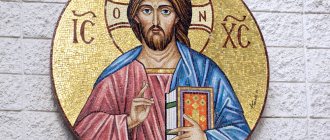So, a woman, from the point of view of the Church, is not at all something unclean
As some liberal-minded individuals suspect. Otherwise, the Church would not have extolled the Most Pure Mother of God so much! I would not honor the host of holy wives and virgins.
Moreover, in the concept of Moral Theology there is no significant difference between a man and a woman, a layman and a priest. Theology sees us as people! People who go to salvation, or people who doom themselves to death. Only such a division.
Interpreting the 15th Rule of the Council of Chalcedon, Balsamon writes: “What is said in this rule has completely fallen out of use; for now deaconesses are not ordained, although some ascetics are not in the proper sense called deaconesses; because there is a rule that women should not enter the holy altar. So, she who cannot enter the holy altar, how will she fulfill the duties of a deacon?” So we stumbled! It turns out that there is a rule stipulating that women should not enter the altar... So, it seems, discrimination begins...
The concept of the altar among Catholics and Orthodox
- In Orthodoxy,
the altar is the eastern part of the temple, which only priests are allowed to enter. It is usually separated from the prayer hall by an iconostasis or simply a fence. And already in the altar itself there is a throne on which the objects necessary for the rituals are located: the Gospel, the antimension and the cross. - In Catholicism,
the altar is the throne itself. They also place a cross, the Gospel, and sometimes items for communion on it: wine and bread. Here the altar is not fenced off, but open. Its purpose is to perform the sacraments. Sometimes several altars are installed at once, more often in large churches.
Let's look for such a rule to understand why women are not allowed to enter the sacred altar
Let us turn to the Syntagma and look at Chapter 22, “That women should not enter the holy altar.” We read: “The 44th canon of the Council of Laodicea considers it inappropriate for the holy altar to be accessible to women, although previously it was also allowed to them. For if this is prohibited for male laymen (by the 69th rule of the VI Ecumenical Council), then even more so it should (be prohibited) for women. And (women are not allowed into the holy altar), as some say, for reasons of involuntary menstruation.”
So that's what it's all about! It turns out that lay men are also prohibited from entering the altar! This is how the 69th Rule of the Sixth Ecumenical Council speaks about this: “None of all those belonging to the category of laity will be allowed to enter the sacred altar. But according to some ancient legend, this is by no means forbidden to the power and dignity of the king when he desires to bring gifts to the Creator.”
So, it is only permissible for the king to enter from the laity, both because he is the anointed one, and only when he brings a gift, i.e. royal ritual gift to the church.
Three main shrines where women are prohibited from entering
The following monasteries have survived to this day where no woman has ever set foot:
- Orthodox monasteries on Mount Athos;
- Lavra of Saint Sava in Israel;
- Stavrovouni Monastery in Cyprus.
Holy Mount Athos
Almost everyone knows that women are not allowed to go to Mount Athos. But how did this ban come about and how strictly is it observed?
The Holy Mountain is also called the earthly inheritance of the Mother of God. It is believed that the only Woman whose foot has set foot on this earth is the Blessed Virgin.
According to legend, in 49, the Mother of God, together with the Apostle John the Theologian, was caught in a storm on Mount Athos - their ship washed ashore. The Most Pure One liked this area so much that she even asked the Lord to make the Holy Mountain Her inheritance. God said that Athos would become not only the Mother of God’s earthly inheritance, but also a refuge for those who wish to be saved.
For a long time, only a few hermits found solitude on the Holy Mountain. But at the beginning of the 8th century their number increased significantly. In 963, the first monastery was founded - the Great Lavra. Over time, Athos turns into a kind of monastic state.
Nowadays, there are 20 active monasteries on the Holy Mountain, where about 1,500 monks and inhabitants live. To get to Mount Athos, a pilgrim needs to obtain a special visa - daimonitirion. It is only available to men and male children. Women are not allowed to go to Mount Athos. Not only to the monasteries, but also to the territory of the Holy Mountain in general.
There are many legends about the end of the world associated with Athos. According to one of them, if women are allowed to enter the Holy Mountain, the end of the world will soon come.
Lavra of Saint Sava the Consecrated
This is one of the most ancient monasteries. It is located in the Judean Desert. It is believed that back in 484, Savva the Sanctified founded this monastery. In addition to Saint Sava, many famous ascetics joined the monastery. Among the most famous are John of Damascus , with whom the story of the image of the Mother of God “Three-Handed” is connected, and John the Silent.
For more than 15 centuries, monastic life has never faded here: even in the most difficult moments, the monastery did not close. Time passes, but life in the monastery does not change, the degree of severity does not decrease. Not only are women not allowed into the Lavra, as well as on Mount Athos, they still don’t use electric light or mobile communications, services are held at night, and only the abbot himself confesses to the brethren and everyone who wants to.
Stavrovouni Monastery in Cyprus
It is interesting that the founder of the monastery is considered to be a woman. It was Queen Helen, Equal to the Apostles, who in 327 stopped at the island during a storm. The idea of founding a monastery here was suggested to her by an Angel. The queen, having landed on the shore, noticed the disappearance of the cross of the prudent robber. But then I saw a shrine on the top of a nearby mountain. Here she founded a monastery, to which she donated the cross of a repentant thief and a piece of the Life-Giving Tree of the Lord with one nail, which was used to bring the Savior.
Over time, the cross of the prudent robber was stolen, but part of the Life-Giving Tree remained in the monastery. Today this particle is considered the largest shrine of Stavrovouni.
The monastery repeatedly succumbed to robbery and destruction, and for a certain period passed into the hands of Catholics. Today it belongs to the Cypriot Orthodox Church and is open to the public. True, only for men. Women are not allowed entry. They can only enter the temple of all Cypriot saints, located near the Stavrovouni monastery.
We invite you to watch a film about life on the Holy Mountain, where you will learn why women are not allowed to go to Mount Athos and what life in a monastic republic looks like from the inside:
Let's try to understand why the Rule does not allow the laity into the altar
I think that there is no need to look for explanatory rules: it’s already clear! The sanctuary is necessary in order for sacred ceremonies to take place. It was separated from the space of the temple so that this place was not only especially holy, but also to prevent disorder and crowding, which happens when there are a large number of people in the church, especially on holidays.
The altar should be the focus of prayer and exceptional order. This is especially important in view of the fact that at the holy meal there is a Chalice with the Divine Blood! At the table - the Lamb of God in the form of Bread! No one should push anyone inadvertently, but there is attention and reverence in everything.
If lay people begin to enter the altar, then the altar will become a passing place, and soon there will be disorder and inconvenience during the sacred ceremony!
And today you can see how the laity sometimes annoy priests who have left the altar for some business. Everyone needs to say something, ask something, give them a note with a lot of explanations, or even give them a gift, and sometimes express a remark or complaint with indignation. Some try to establish their own customs at the place where they stand... And all this can enter the altar!
Therefore, it was a completely wise decision of the Holy Fathers that only those serving the Holy Mysteries should be in the altar!
Story
Altars appeared at the dawn of Christianity. In those days, in the catacomb churches, where Christians were sometimes forced to hide, the relics of the holy martyrs were fenced off in the eastern part. The relics were kept in a sarcophagus - a special stone tomb. It was there that the Sacrament of the Eucharist was performed in remembrance of our Lord Jesus Christ according to His Testament.
The altars were located on a higher elevation compared to the other areas of the temple and symbolized the Throne of the Lord. Therefore, they always try to keep the Altar clean and decorate it with carpets, but not everyone has the right to enter there. Where the Sacrament of the Eucharist is celebrated, the Last Supper symbolically takes place, when Christ gathered His disciples. Previously, in Old Testament times, the altar was called the “Holy of Holies.”
Altar servers have their own responsibilities and rules
- Before entering the altar, you must kiss the icon on the gate.
- Then bow three times with the sign of the cross. On weekdays - bows to the ground, on holidays - bows.
- Next, ask for a blessing from the located priest.
- When passing near a mountainous place, you need to cross yourself.
- Under no circumstances should you talk or laugh loudly.
- During the Gospel, the reading of the canon and the Cherubic song, noise must not be allowed. Only prayer should be heard.
- It is strictly forbidden to touch the throne and the altar.
- It is necessary to try to walk in front of the Throne as little as possible.
- You cannot bring any food with you.
- It is forbidden to pass through the Royal Gate.
- It is unacceptable to carry technical equipment with you.
- It is also undesirable to distract the clergyman with questions.
- In case of any external bleeding, the altar server must leave.
In some nunneries, women - nuns in old age - are allowed into this part. And even less often is one of the parishioners allowed to the altar.
Let's try to understand why the limits of being at the altar for the laity are so strict.
According to Archimandrite Alypiy Svetlichny, the exclusion of this category of parishioners occurs for objective reasons:
- Women - due to “monthly involuntary flow.”
- Ordinary parishioners - because the altar is a sanctuary.
The altar is the center, order should reign there. That is why it is separated from the rest of the temple area in order to preserve the sanctity of this place. Eliminate fuss, noise and crowding, which is inevitable with large crowds of people.
If all lay people are allowed to enter the altar, it will cease to be a sacred place, but will become a place of passage. And hence - a completely understandable disorder and, accordingly, obstacles to the performance of sacred rites.
So, we tried to give answers to the questions that interest you, one of which is “Why are women not allowed to enter the altar?”
Everyone knows that when visiting church it is necessary to follow certain rules of conduct, many of which seem to apply only to women. From the point of view of a modern person, it is impossible to rationally explain them, and in order to find out, for example, why women cannot enter the altar, you will have to seek clarification from an Orthodox priest - or read this article.
Certain Requirements to be Observed by the Church
- For both Catholics and Orthodox Christians, the altar should be located in the eastern part of the temple and face east.
- Catholics should have no more than one service per day at one altar. This sometimes explains the presence of several altars in one temple.
- In Orthodoxy, only clergy of the highest hierarchy are allowed into the altar.
- According to the law of church law, only presbyters, bishops and deacons can receive communion at the altar. But in practice, it is sometimes allowed for the laity to receive communion at the altar (in exceptional cases). For example, students of theological seminaries.
Only altar servers are allowed to the altar. These are men who, of their own free will, assist the clergy at the altar. That's why they are called that.
What about Catholics?
In all Christian churches, the altar takes pride of place. Representatives of all denominations of Christianity treat this sacred place with special reverence. In a Catholic church, the altar or presbytery is located behind a low partition, and it is not difficult for anyone to step over it. However, this should not be done, since ordinary parishioners are prohibited from doing this in the same way as in Orthodox churches. Ordinary laity are allowed to enter the presbytery only in cases of extreme necessity.











